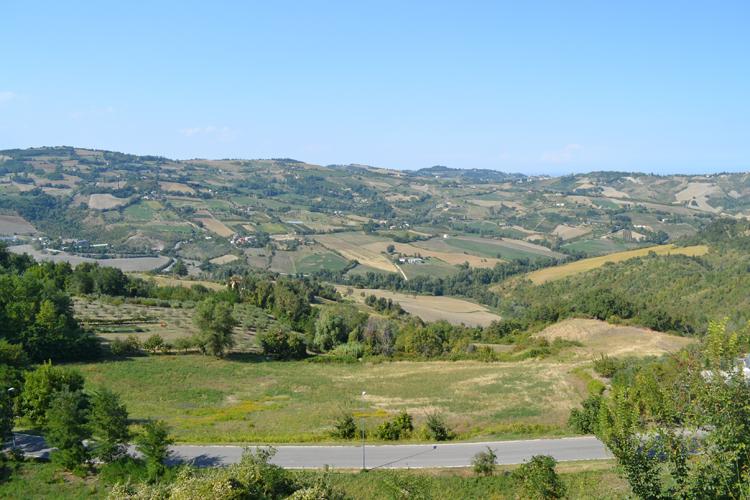There’s more to Romagna than seaside resorts. In the second part of the "Loving Romagna" tour attended by our contributing editor Silvia, we venture inland to discover charming hamlets and artisan food and wine producers. Read Part One here.
During the Middle Ages and the Renaissance, Romagna was ruled by one of Italy’s most important families, the Malatesta. They were based in Rimini, and were often involved in bloody battles with their neighboring enemies, the Montefeltro, dukes of Urbino.
This was a frontier territory, disputed for centuries by the Papal States, and often under attack by armies in favor or against the Church. For this reason, numerous fortresses, castles and fortified villages were built by the Malatesta in the hilltops rising behind the coast.
One such village is the enchanting Sant’Arcangelo di Romagna, about 15 minutes from Bellaria-Igea Marina, my base for the Loving Romagna tour. Positioned on a hillock, surrounded by walls erected by the Malatesta, the town has a medieval layout, dating to the 13th century, with tiny winding streets, staircases, small balconies adorned with colorful flowers, and beautiful views of the surrounding landscape - Romagna charm at its best.

Sant’Arcangelo makes for an exquisite day visit. I was lucky to be shown around by Giorgio, the incredibly knowledgeable guide of the local Pro Loco tourist association. Among the highlights of the visit were the eerie Tufa Caves, a network of 152 tunnels built inside the hillock, under the old town, excavated between the 6th and 15th centuries. The caves are thought to have had different uses and purposes: wine cellars (“Romagnoli are serious drinkers”, the guide told the group, and I suppose they have been for quite some time), storage space, hiding place (they served in World War II to defend the inhabitants from bombing). Another impressive site is the Malatesta residence-fortress, whose current appearance dates to 1447 when Sigismondo Pandolfo gave it a square shape and added three stout polygonal towers to make it sturdier. Important remains of Sant’Arcangelo’s rich history are everywhere: Porta Cervese, the only remaining entrance gate from the Middle Ages; a rare medieval well in the town’s prettiest square, Piazza delle Monache; the triumphal arch designed in the 18th century in honor of Pope Clement XIV, a native of Sant’Arcangelo; the Campanone Tower, one of the town’s symbols; the Collegiata, the town’s main church.
Don’t leave Sant’Arcangelo without a visit to the impressive Stamperia Marchi, one of the oldest fabric-making businesses of the area, operating since the 17th century. Preserving the ancient local tradition of rust-printed fabrics, the stamperia was built to house the “mangano”, the huge wooden wheel used to bring out the shine in the fabric; it is possibly the only still functioning mangle left in the world for weight and dimensions from that period. The beautiful embroidery is entirely handmade, requiring skill and patience.

To flaunt their wealth, the Malatesta often organized sumptuous banquets. Some of the foods from those ancient times can still be found on the tables of the Romagnoli today. This is the case for “formaggio di fossa”, Fossa cheese, which is produced following a tradition passed on through the centuries in the valley between the Rubicone (yes, the one of Julius Caesar’s fame) and Marecchia rivers. The best place to learn about and taste this unique cheese is the Fossa Pellegrini in Sogliano, where some of the “fosse” – underground pits where the cheese is left to ripe – are located.
The key element here is the sandstone terrain where the pits have been excavated, which creates the right temperature and humidity. After two months of pre-aging, the cheese is buried into the pits during the first weeks in August where it remains until the beginning of November. During this time, it re-ferments, acquiring a uniquely pungent, slightly bitter taste. Fossa cheese can be made with cow’s milk, sheep’s milk or a combination of both. It can be eaten by itself, used in quiches, or grated on pasta.

The best wine to wash it down with? Sangiovese di Romagna, of course – this is the wine that defines the area. Native to Romagna, this vine variety produces a ruby-red wine with violet nuances, with a dry, full, harmonic taste. They say Sangiovese evokes the character of the people of Romagna: frank, a bit rough at times, yet gentle and open. Sangiovese is excellent with red meats, hearty dishes of fresh pasta, and aged cheese.
If you’d like to learn how Sangiovese is made, head to Tenuta Carbognano, a three-hectare family-run vineyard in the Val Conca, whose Sangiovese Superiore has been awarded a prize for the best Sangiovese produced in the Rimini hills. The husband-and-wife team will take you for a walk among the vineyards to let you in on the production methods, followed by an al fresco tasting on the porch outside their farm, overlooking the vineyards and the countryside.
Pure Romagna bliss.

Note by author: I was a guest on the Loving Romagna tour organized by Maria Regina Rubinetti of Hotel Eliseo in Bellaria-Igea Marina. All opinions my own.








